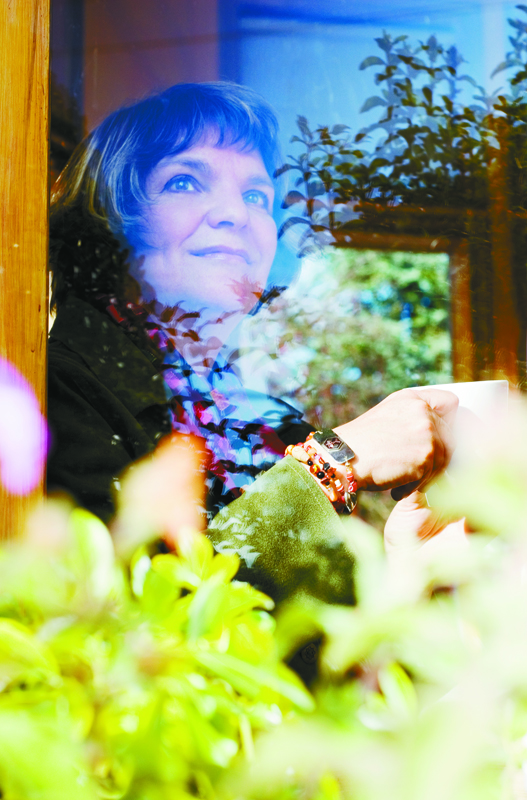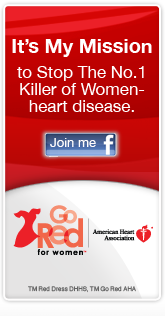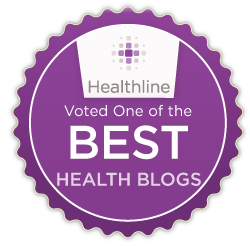This guest author is the first heart sister I found after my heart attack. Looking online for anything that would help me make sense of what happened to me, I found Carolyn Thomas’ blog, Heart Sisters, and discovered her amazing in-depth research articles about women and heart disease. Carolyn is a speaker, advocate, certified health blogger, founding member of the Society for Participatory Medicine, a Mayo Clinic/WomenHeart leadership symposium alumna (and more!) — in short, she is a major role model for me.
I’m so grateful that Carolyn is sharing one of my favorite posts from her blog, originally posted in June 2012. This idea that there’s a survivorship vacuum for heart disease strikes a nerve for me. A heart attack is not an event — like a car accident that you miraculously survive and then put behind you — it is a symptom of and outcome of a disease, a lifelong illness that we need help surviving so that we can get on with living.

Where’s the “survivorship” model for heart patients?
“There may be times when the joy you feel about survival far outweighs any anxieties you may have.
“Then, there will be times when your fears and uncertainties seem to take over your life, and you wonder if you will ever feel normal again.”
This sounds so familiar to any of us who have survived a catastrophic cardiac event, doesn’t it?
But these words were not written about heart patients –- they’re for cancer survivors. Which made me wonder about this thing known as “survivorship” — a popular concept in oncology that defines a cancer survivor “from the time of diagnosis and for the balance of life.” But where, I ask you, is the concept of “survivorship” for heart patients? And why haven’t I found it yet?
This widely accepted term is largely credited to an organization called the National Coalition for Cancer Survivorship. Their award-winning Cancer Survival Toolbox® is a free, self-learning audio program “to help people develop important skills to better meet and understand the challenges of their illness.” For example, the toolbox contains audio podcasts with topics like: “Understand that you are an individual, NOT a statistic!”
Sounds great! But where’s our Heart Disease Survival Toolbox for heart patients?
Did you know that there are many books devoted to the subject of cancer survivorship? Books like Everyone’s Guide to Cancer Survivorship, or Cancer Survivorship: Today and Tomorrow, or Handbook of Cancer Survivorship, or Implementing Cancer Survivorship Care Planning.
Did you know that there are Survivorship Centres, like the Ottawa Regional Cancer Foundation’s Maplesoft Centre? It’s a lovely building which “incorporates the five Wu Xing elements of fire, earth, metal, water and wood – to help provide balance and harmony to the lives of cancer survivors.”
Did you know that there are even Cancer Survivor Parks? The R.A. Bloch Cancer Foundation, for example, has provided millions of dollars to build 25 of these cancer survivor parks across the United States and Canada, each featuring therapeutic elements like “positive mental attitude walks” amid beautiful urban settings.
Again, where are the podcasts and guidebooks and patient centres and therapeutic parks and healing gardens developed specifically to enhance our experiences as heart patients?
In 1985, The New England Journal of Medicine published Dr. Fitzhugh Mullan’s account of his own diagnosis and treatment of cancer. In that article, Dr. Mullan defined three primary seasons of cancer survivorship, which he termed:
- acute survivorship
- extended survivorship
- permanent survivorship
Then in July 2010, Dr. Kenneth Miller wrote a column for Medscape Education Oncology called “Symptom Management and the Seasons of Cancer Survivorship,” in which he proposed a revised model for these “seasons” of survivorship. Within this framework, he wrote, various symptoms may appear, disappear, and then reappear over time.
Hmmmm . . . just like heart disease symptoms frequently behave.
So while we’re waiting for the field of cardiology to come up with a revised model for the seasons of survivorship for us (what the heck, any kind of model at all, revised or not!) let’s consider some of the highlights of Dr. Miller’s proposed list. Just try substituting the words heart disease for cancer:
Acute Survivorship
“The stage of acute survivorship begins at the moment of diagnosis and extends through treatment. Common symptoms affecting survivors in this stage often include nausea and pain as well as anxiety and depression.
Transitional Survivorship
“Once the initial phase of diagnosis and treatment has ended, the stage of transitional survivorship begins – a transition back to “normal” or a “new normal.” This is the stage in which the medical team is less involved, and relief and celebration by the survivor might be mixed with, or supplanted by, feelings of isolation and depression.
Extended Survivorship
“A large number of cancer survivors who are disease-free following treatment and who are living with varying risks for recurrence find themselves in this stage. Extended survivorship represents a period when the risk for disease recurrence may be diminishing, although a survivor’s anxiety level about the risk can either be directly proportional to the objective risk or, ironically, inversely proportional to it.
Chronic Survivorship
“There is a growing number of cancer survivors who are “living with cancer” as a chronic disease and are in the stage of chronic survivorship. For chronic survivors, day-to-day life may have many normal aspects, but the fear of recurrence or disease progression is often an ever-present concern.
Permanent Survivorship
“The survivors in the permanent season of cancer survivorship are a heterogeneous group. Some are cancer-free and free of cancer while others are cancer-free but not free of cancer – either physically or emotionally. Finally, some remain in this stage, but re-enter the stage of acute survivorship because of a secondary cancer caused by therapy for the original cancer, while others may develop a second, unrelated cancer.
“Permanent survivors who are cancer-free and free of cancer look at cancer as part of their past medical history, and have little or no late or long-term medical, emotional, or other sequelae of the experience.
“By contrast, some permanent survivors are cancer-free but not free of cancer – they are left with medical, emotional, financial or spiritual “fallout” from the experience. Medically, they might have any of a wide range of problems as well as physical changes and functional limitations as a result of surgery. Emotional issues in these survivors can range from mild anxiety to long-term depression or Post-Traumatic Stress Disorder.”
I felt equal parts inspired and dismayed while reading Dr. Miller’s holistic overview of the cancer patient’s journey:
“inspired” because of the profound value to cancer patients in being heard and seen in such a humane fashion, far more than being merely today’s 10 o’clock clinical procedure
“dismayed” because I’ve been seeking a model exactly like this that mirrors my own journey as a heart attack survivor – yet didn’t even realize I was seeking it until I read about cancer survivorship
In other words, why do they have what we don’t? And what can we do about it?
Heart disease remains a chronic and progressive diagnosis. Our hardworking docs can patch us up, stent us, bypass us, zap our wonky electrical circuits, implant lifesaving devices in our hearts, order our prescription drugs, pat us on the heads and discharge us home from CCU – but what they cannot do is fix what caused our cardiac events in the first place (often decades earlier).
We know that one of the most significant risk factors for having a heart attack is having already had one. Among patients who survive their first heart attack, 21% of men and 33% of women will experience another one within six years (and that stat, by the way may jump 1.5 times higher if you don’t make permanent wholesale lifestyle changes).
None of us living with heart disease has a “five-year survival anniversary” date circled on a future calendar that we can then meaningfully celebrate.
And surprisingly, we heart patients make up barely 2% of all diagnoses discussed online by patients on social media, slumped down in the second smallest diagnostic category (we beat out Alzheimer’s patients) according to research from the Minneapolis-based marketing firm Russell Herder. You might wonder how that is even possible – given that, compared to every other disease included in this study’s findings, heart disease is our biggest killer. This study, called Seeking Social Solace, identified trends in how patients with serious medical conditions are using social media platforms. Turns out – heart patients are not!
So I’ve been limping along here, reading, and writing, and trying to make sense of the vagaries of what I simply know as “living with heart disease”.
The closest I’ve come is to happen upon the work of cardiac psychologist Dr. Wayne Sotile and his useful book, Thriving With Heart Disease.
For us living with heart disease, there are:
- no cardiac survivorship centres
- no heart disease survivor parks
- no survivorship coronary care plan textbooks for our physicians
And then somehow, amazingly, one day four years after my own life-altering heart attack, I stumble upon this “seasons of survivorship” model, born of cancer patients – but a well-accepted clinical model that seems to exquisitely capture the lived experience of those who have survived a cardiac event as well (and likely many other life-limiting medical conditions).
Again, I’m compelled to ask: isn’t it about time that heart disease – our #1 killer – deserves to be viewed within the same professional framework that informs the world of cancer survivorship?
© 2012 Carolyn Thomas www.myheartsisters.org
 Carolyn Thomas writes the award-winning website Heart Sisters about women and heart disease. She was named of one of ShareCare’s 2012 Heart Disease: Top 10 Online Influencers and one of Healthline’s 10 Best Heart Disease Blogs. She was also named a “Women’s Health Hero” for 2009 by Our Bodies Ourselves.
Carolyn Thomas writes the award-winning website Heart Sisters about women and heart disease. She was named of one of ShareCare’s 2012 Heart Disease: Top 10 Online Influencers and one of Healthline’s 10 Best Heart Disease Blogs. She was also named a “Women’s Health Hero” for 2009 by Our Bodies Ourselves.
Carolyn is an alumna of the annual WomenHeart Science & Leadership Symposium for Women with Heart Disease at Mayo Clinic in Rochester, Minnesota and was awarded an ePatient scholarship to attend Stanford University’s ‘Medicine X’ Conference.
Carolyn started researching her big handful of daily pills and became alarmed enough about Big Pharma that she launched another website, The Ethical Nag: Marketing Ethics for the Easily Swayed.
And oh, she survived a heart attack (the widowmaker) in 2008.



Hello Jen and thanks so much for reposting my “survivorship” blog article here. The stark difference between what’s been done for cancer patients (compared to what hasn’t been done for heart patients) is disturbing. Thanks for helping to raise awareness of this issue on your excellent site.
Keep up the good work, sister!
regards,
C.
Thank YOU, Carolyn, for sharing it with me! After we’re through making sure women know heart disease is their #1 health threat, then I suppose we could tackle the survivorship work. Not that I’d mind if someone else just did it first.
Thanks again –
Jen